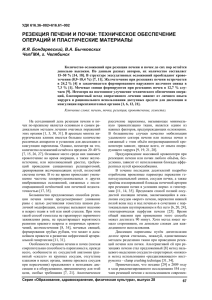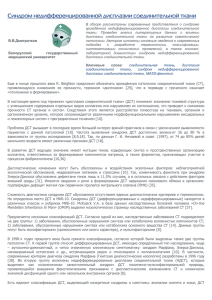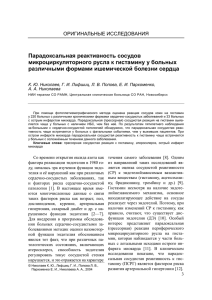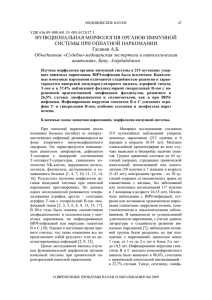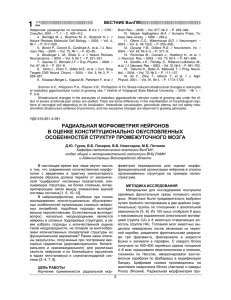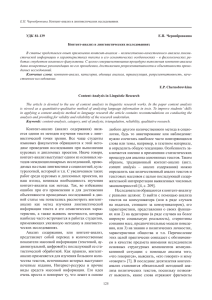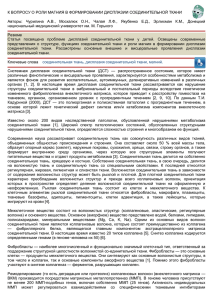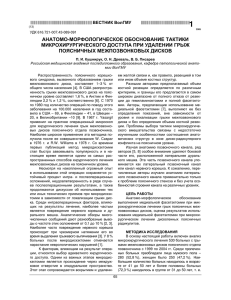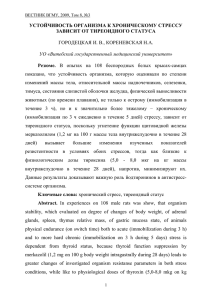БИОЛОГИЧЕСКАЯ ИСКУССТВЕННАЯ ПЕЧЕНЬ BIOLOGICAL
advertisement
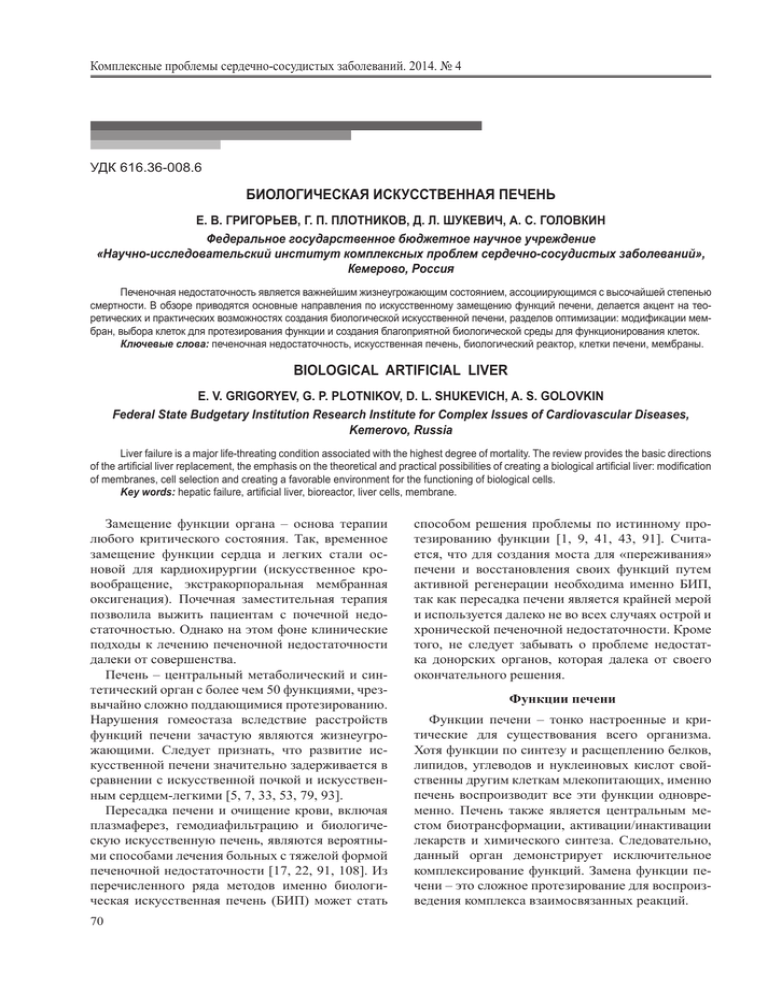
- . 2014. 4 616.36-008.6 . . « , . . , . . - , , . . - , . : , , , , », , , : , . . - BIOLOGICAL ARTIfICIAL LIVER E. V. GRIGORYEV, G. P. PLOTNIKOV, D. L. ShUKEVICh, A. S. GOLOVKIN Federal State Budgetary Institution Research Institute for Complex Issues of Cardiovascular Diseases, Kemerovo, Russia Liverfailureisamajorlife-threatingconditionassociatedwiththehighestdegreeofmortality.thereviewprovidesthebasicdirections oftheartiicialliverreplacement,theemphasisonthetheoreticalandpracticalpossibilitiesofcreatingabiologicalartiicialliver:modiication ofmembranes,cellselectionandcreatingafavorableenvironmentforthefunctioningofbiologicalcells. Key words: hepaticfailure,artiicialliver,bioreactor,livercells,membrane. – . , - ( , ). » [1, 9, 41, 43, 91]. « , , - . . – . , 50 . , , . . – . , - - , , , , [5, 7, 33, 53, 79, 93]. , . - , [17, 22, 91, 108]. ( 70 ) – , . / , . . . . , . . . 1 ( 1958 Killey 1958 Schechter 1958 Lee 1958 Hori 1965 Yatzidis 1965 Eisemann 1967 Burnell 1968 Sabin 1970 Abouna 1976 Opolon 1976 Knell 1978 Yamazaki 1980 Brunner 1982 Ozawa 1985 Teraoka 1987 Matsumara 1988 Marguilis 1992 Yoshiba 1993 Demetriou 1994 2000 Gerlach Stange , • • , : : • , 450, ), . . - - , : • ( : , • . . : , [93]) (MARS) - • . , , , , - ( . – , , )– , 90 %. – . – . , . , • • - . . , - . , . , 71 , - ), , ( . , , . . , - - ), , . , - [14]. , , [1, 33, 79, 96]. (2000 . [1]. - 1500–5000 ) , . - . . , . - . ( 50 000 ). [1]. ( , - - , , . . , - - . . , , . [11, 85]. ex vivo - [23, 108]. ( ) 72 , , , [10, 96]. , - . - , [15]. , L- - . - , - . [108]. ). , - . , ( , , - , , , - . . , . . . . 2. - ( ) [79,114]. , . , - , HLA ) . . 3. , - , . - ( . [10, 11, 82, 97]. , : 1. , - real liver assist device) , . . , (ELAD – extracorpo- . , , , , 1,5 [5, 62]. - , 10–30 % . : 1) , , 2) . 2 [14] - - ELAD – 3 – , - 400 2 / HepatAssist RFB HBAL/ TECA 400 - 100–250 , AMCBAL MELS , BLSS – 300– / , – - / , , - 150 70 , - – –1 - 120 – 0,45 , – 0,15–0,20 / / 100 / 2 / / 200–250 / 200–300 / 400 1 - 95 % 5% /N2 2 0,4 / 2 95 % 5% / - 0,4 / 2 100 73 ( ). [33]. , , . . , 150 , 36 30 10 % , « , . , - - . [79]. - . [30, 85, 88, 120]. . - ) - . - - - , , [20]. - , 1975 . , : 200 , » (400–1500 Wolfe , 100 200 [64, 104]. - , , - , . ) . , , , ( , , . – 15 . - « . » - , . – . , - . , , , ( [21, 83]. , , ) 74 . - , , , [29, 44, 60, 71, 73, 74]. ( ) , . - [53]. . , , - . , , , [6, 36, 53, 59, 99]. . . , - . . , . . ). ( . , 63, 103, 119]. . , – . . . . [48, 51, 72, 77]. , , . - , , , [67, 110]. , - MARS , [116]. . , . , . ( ). , , - , - . . ELAD , / . [18, 56]. , , [24–26, 112]. - , . – . [66, 69, 92, 126]. . - , , . 3 [50] [41]. - - . , - . , : - . ( , , , - , , , . [39, - ). ( ) 450 75 , , - . , . - . « – – , – » . - [85]. . . - , , , [71, 82, 87]. , - , , ). , ( . - , . . , 116, 118]. 1. « 2. , [27, » . - . 76 - 3. , ( - , ). 1. A biological extracorporeal metabolic device for hepatic support / I. Koshino [et al.] // Trans. Amer. Soc. Artif. Intern. Organs. 1975. Vol. 21. P. 492. 2. A comparative study of proliferation and hepatic differentiation of human adipose-derived stem cells / R. Coradeghini [et al.] // Cells Tissues Organs. 2010. Vol. 191. P. 466–477. 3. A reversibly immortalized human hepatocyte cell line as a source of hepatocyte-based biological support / N. Kobayashi [et al.] // Addict Biol. 2001. Vol. 6. P. 293–300. 4. A tightly regulated immortalized human fetal hepatocyte cell line to develop a bioartiicial liver / N. Kobayashi [et al.] // Transplant. Proc. 2001. Vol. 33. P. 1948–1949. 5. Adham M. Extracorporeal liver support: waiting for the deciding vote // ASAIO J. 2003. Vol. 49. P. 621–632. 6. Adipose tissue-derived mesenchymal stem cells as a source of human hepatocytes / A. Banas [et al.] // Hepatology. 2007. Vol. 46. P. 219–228. 7. Alginate-encapsulated HepG2 cells in a luidized bed bioreactor maintain function in human liver failure plasma / S. M. Coward [et al.] // Artif. Organs. 2009. Vol. 33. P. 1117–1126. 8. Alginate-encapsulated human hepatoblastoma cells in an extracorporeal perfusion system improve some systemic parameters of liver failure in a xenogeneic model / T. M. Rahman [et al.] // Artif. Organs. 2004. Vol. 28 P. 476–482. 9. Artiicial and bioartiicial support systems for acute and acute-on-chronic liver failure: a systematic review / L. L. Jaergard [et al.] // JAMA. 2003. Vol. 289. P. 217–222. 10. Artiicial liver support devices for fulminant liver failure / A. Sechser [et al.] // Clin. Liver. Dis. 2001. Vol. 5. P. 415–430. 11. Bioartiicial liver support: report of the longest continuous treatment with human hepatocytes / J. M. Millis [et al.] // Transplant. Proc. 2001. Vol. 33. P. 1935. 12. Biochemical and molecular characterization of hepatocyte-like cells derived from human bone marrow mesenchymal stem cells on a novel three-dimensional biocompatible nanoibrous scaffold / S. Kazemnejad [et al.] // J. Gastroenterol. Hepatol. 2009. Vol. 24. P. 278–287. 13. Bridging a patient with acute liver failure to liver transplantation by the AMC-bioartiicial liver / M. P. van de Kerkhove [et al.] // Cell Transplant. 2003. Vol. 12. P. 563–568. 14. Brunner G., Holloway C. J., Lösgen H. The application of immobilized enzymes in an artiicial liver support system // Artif. Organs. 1979. Vol. 3. P. 27–30. 15. Brunner G., Tegtimeier F. Enzymatic detoxiication using lipophilic hollow iber membranes // Artif. Organs. 1984. Vol. 8. P. 161–166. 16. Caron J. M., Bissel D. M. Extracellular matrix induces albumin gene expression in cultured rat hepatocytes // Hepatology. 1989. Vol. 10 (4). P. 636. 17. Carpentier B., Gautier A., Legallais C. Artiicial and bioartiicial liver devices: present and future // Gut. 2009. Vol. 58. P. 1690–1702. 18. Cell-free hemoglobin-based blood substitutes and risk of myocardial infarction and death: a meta-analysis / C. Natanson [et al.] // JAMA. 2008. Vol. 299. P. 2304–2312. . . , . . . 19. Cell-free supernatant from hepatocyte cultures improves survival of rats with chemically induced acute liver failure / P. LaPlante-O’Neill [et al.] // J. Surg. Res. 1982. Vol. 32. P. 347. 20. Cells for bioartiicial liver devices: the human hepatoma-derived cell line C3A produces urea but does not detoxify ammonia / D. Mavri-Damelin [et al.] // Biotechnol. Bioeng. 2008. Vol. 99. P. 644–651. 21. Chamuleau R. A., Deurholt T., Hoekstra R. Which are the right cells to be used in a bioartiicial liver? // Metab. Brain. Dis. 2005. Vol. 20. P. 327–335. 22. Chamuleau R. A. Future of bioartiicial liver support // World J. Gastrointest. Surg. 2009. Vol. 1. P. 21–25. 23. Chang T. M. S. Experience with the treatment of acute liver failure patients by hemoperfusion over biocompatible microencapsulated (coated) charcoal // Artiicial Liver Support / I. M. Murray-Lyon (eds), R. Williams. England. Tunbridge Wells: Pitman Medical, 1975. 367 p. 24. Chen G., Palmer A. F. Hemoglobin-based oxygen carrier and convection enhanced oxygen transport in a hollow iber bioreactor // Biotechnol. Bioeng. 2009. Vol. 102. P. 1603–1612. 25. Chen G., Palmer A. F. Mixtures of hemoglobin-based oxygen carriers and perluorocarbons exhibit a synergistic effect in oxygenating hepatic hollow iber bioreactors // Biotechnol. Bioeng. 2010. Vol. 105. P. 534–542. 26. Chen G., Palmer A. F. Perluorocarbon facilitated O2 transport in a hepatic hollow iber bioreactor // Biotechnol. Prog. 2009. Vol. 25. P. 1317–1321. 27. Clinical application of bioartiicial liver support systems / M. P. van de Kerkhove [et al.] // Ann. Surg. 2004. Vol. 240. P. 216–230. 28. Clinical extracorporeal hybrid liver support-phase I study with primary porcine liver cells / I. M. Sauer [et al.] // Xenotransplantation. 2003. Vol. 10. P. 460–469. 29. Concise review: isolation and characterization of cells from human term placenta: outcome of the irst international Workshop on Placenta Derived Stem Cells / O. Parolini [et al.] // Stem. Cells. 2008. Vol. 26. P. 300–311. 30. Cowan P. J., d’Apice A. J. The coagulation barrier in xenotransplantation: incompatibilities and strategies to overcome them // Curr. Opin. Organ. Transplant. 2008. Vol. 13 P. 178–183. 31. Cultivation of immortalized human hepatocytes HepZ on macroporous CultiSpher G microcarriers / A. Werner [et al.] // Biotechnol. Bioeng. 2000. Vol. 68. P. 59–70. 32. Dan Y. Y., Yeoh G. C. Liver stem cells: a scientiic and clinical perspective // J. Gastroenterol. Hepatol. 2008. Vol. 23. P. 687–698. 33. Demetriou A. A. Hepatic assist devices // Panminerva Med. 2005. Vol. 47. P. 31–37. 34. Development of a bioartiicial liver: Properties and function of a hollow-iber module inoculated with liver cells / J. Rozga [et al.] // Hepatology. 1993. Vol. 17. P. 258. 35. Differentiating characterization of human umbilical cord blood-derived mesenchymal stem cells in vitro / X. Q. Kang [et al.] // Cell .Biol. Int. 2006. Vol. 30. P. 569–575. 36. Differentiation and transplantation of human induced pluripotent stem cell- derived hepatocyte-like cells / S. Asgari [et al.] // Stem. Cel.l Rev. 2013. Vol. 9 (4). P. 493–504. DOI 10.1007/s 12015-011-9330y 37. Differentiation of human adipose stromal cells into hepatic lineage in vitro and in vivo / M. J. Seo [et al.] // Biochem. Biophys. Res. Commun. 2005. Vol. 328. P. 258–264. 38. Differentiation of human embryonic stem cells into hepatocytes in 2D and 3D culture systems in vitro / H. Baharvand [et al.] // Int. J. Dev. Biol. 2006. Vol. 50. P. 645–652. 39. Differentiation of human umbilical cord mesenchymal stromal cells into low immunogenic hepatocyte-like cells / Q. Zhao [et al.] // Cytotherapy. 2009. Vol. 11. P. 414–426. 40. Differentiation of mesenchymal cells derived from human amniotic membranes into hepatocyte-like cells in vitro / T. Tamagawa [et al.] // Hum. Cell. 2007. Vol. 20. P. 77–84. 41. Ding Y. T., Shi X. L. Bioartiicial liver devices: Perspectives on the state of the art // Front. Med. 2011. Vol. 5. P. 15–19. 42. Donato M. T., Castell J. V., Gómez-Lechón M. J. Characterization of drug metabolizing activities in pig hepatocytes for use in bioartiicial liver devices: comparison with other hepatic cellular models // J. Hepatol. 1999. Vol. 31. P. 542–549. 43. Early clinical experience with a hybrid bioartiicial liver / A. A. Demetriou [et al.] // Scand. J. Gastroenterol. 1995 (Suppl). Vol. 208. P.111–117. 44. Early experiences with a porcine hepatocyte-based bioartiicial liver in acute hepatic failure patients / E. Morsiani [et al.] // Int. J. Artif. Organs. 2002. Vol. 25. P. 192–202. 45. Effect of human patient plasma ex vivo treatment on gene expression and progenitor cell activation of primary human liver cells in multi-compartment 3D perfusion bioreactors for extra-corporeal liver support / E. Schmelzer [et al.] // Biotechnol. Bioeng. 2009. Vol. 103. P. 817–827. 46. Effect of human umbilical cord blood-derived mesenchymal stem cells in a cirrhotic rat model / K. H. Jung [et al.] // Liver Int. 2009. Vol. 29. P. 898–909. 47. Effects of artiicial liver support system on patients with acute or chronic liver failure / W. B. Du [et al.] // Transplant. Proc. 2005. Vol. 37. P. 4359–4364. 48. Enhanced functions of human embryonic stem cell-derived hepatocyte-like cells on three-dimensional nanoibrillar surfaces / Z. Farzaneh [et al.] // Stem. Cell. Rev. 2010. Vol. 6 P. 601–610. 49. Establishment of a highly differentiated immortalized human hepatocyte cell line as a source of hepatic function in the bioartiicial liver / N. Kobayashi [et al.] // Transplant. Proc. 2000. Vol. 132. P. 237–241. 50. Evaluation of a new immortalized human fetal liver cell line (cBAL111) for application in bioartiicial liver / P. P. Poyck [et al.] // J. Hepatol. 2008. Vol. 48. P. 266–275. 51. Ex vivo characteristics of human amniotic membranederived stem cells / J. Kim [et al.] // Cloning Stem Cells. 2007. Vol. 9. P. 581–594. 52. Extracorporeal bioartiicial liver using the radial-low bioreactor in treatment of fatal experimental hepatic encephalopathy / H. Kanai [et al.] // Artif. Organs. 2007. Vol. 31. P. 148–151. 53. Fausto N. Liver regeneration and repair: hepatocytes, progenitor cells, and stem cells // Hepatology. 2004. Vol. 39. P. 1477–1487. 54. First clinical use of a novel bioartiicial liver support system (BLSS) / G. V. Mazariegos [et al.] // Am. J. Transplant. 2002. Vol. 2. P. 260–266. 55. Formation of multicellular spheroids composed of adult rat hepatocytes in dishes with positively charged surfaces and under other nonadherent environments / N. H. Koide [et al.] // Exper. Cell. Res. 1990. Vol. 186. P. 227. 56. Hay P. D., Veitch A. R., Gaylor J. D. Oxygen transfer in a convection-enhanced hollow iber bioartiicial liver // Artif. Organs. 2001. Vol. 25. P. 119–130. 77 57. Hepatic differentiation from human mesenchymal stem cells on a novel nanoiber scaffold / M. Ghaedi [et al.] // Cell. Mol. Biol. Lett. 2012. Vol. 17. P. 89–106. 58. Hepatic differentiation of amniotic epithelial cells / F. Marongiu [et al.] // Hepatology. 2011. Vol. 53. P. 1719–1729. 59. Hepatic stem cells: from inside and outside the liver? / M. R. Alison [et al.] // Cell. Prolif. 2004. Vol. 37. P. 1–21. 60. Hepatogenesis of adipose-derived stem cells on polylactidecoglycolide scaffolds: in vitro and in vivo studies / M. Wang [et al.] // Tissue. Eng. Part. C. Methods. 2010. Vol. 16. P. 1041–1050. 61. Hepatogenic differentiation of human mesenchymal stem cells from adipose tissue in comparison with bone marrow mesenchymal stem cells / R. Taléns-Visconti [et al.] // World J. Gastroenterol. 2006. Vol. 12. P. 5834–5845. 62. Human hepatocyte functions in a crossed hollow iber membrane bioreactor / L. De Bartolo [et al.] // Biomaterials. 2009. Vol. 30. P. 2531–2543. 63. Human umbilical cord matrix stem cells eficiently rescue acute liver failure through paracrine effects rather than hepatic differentiation / S. Zhang [et al.] // Tissue. Eng. Part. A. 2012. Vol. 18. P. 1352–1364. 64. In vitro assessment of encapsulated C3A hepatocytes functions in a luidized bed bioreactor / B. David [et al.] // Biotechnol. Prog. 2004. Vol. 20. . 1204–1212. 65. In vitro differentiation of human umbilical cord bloodderived mesenchymal stem cells into hepatocyte-like cells / S. H. Hong [et al.] // Biochem. Biophys. Res. Commun. 2005. Vol. 330. P. 1153–1161. 66. In vitro hepatic differentiation of human mesenchymal stem cells / K. D. Lee [et al.] // Hepatology. 2004. Vol. 40. P. 1275–1284. 67. In vivo hepatic differentiation of mesenchymal stem cells from human umbilical cord blood after transplantation into mice with liver injury / J. Yu [et al.] // Biochem. Biophys. Res. Commun. 2012. Vol. 422. P. 539–545. 68. In-depth physiological characterization of primary human hepatocytes in a 3D hollow-iber bioreactor / D. Mueller [et al.] // J. Tissue. Eng. Regen. Med. 2011. Vol. 5. P. e207–218. 69. Induced pluripotent stem cells: a new era for hepatology / S. Asgari [et al.] // J. Hepatol. 2010. Vol. 53. . 738–751. 70. Inducing proliferation of human amniotic epithelial (HAE) cells for cell therapy / S. Terada [et al.] // Cell. Transplant. 2000. Vol. 9. P. 701–704. 71. Initial experience with the modiied extracorporeal liver-assist device for patients with fulminant hepatic failure: system modiications and clinical impact / J. M. Millis [et al.] // Transplantation. 2002. Vol. 74. P. 1735–1746. 72. Isolation and characterization of a stem cell population from adult human liver / M. B. Herrera [et al.] // Stem. Cells. 2006. Vol. 24. P. 2840–2850. 73. Isolation and characterization of adult human liver progenitors from ischemic liver tissue derived from therapeutic hepatectomies / H. Stachelscheid [et al.] // Tissue. Eng. Part. A. 2009. Vol. 15. P. 1633–1643. 74. Isolation and characterization of stem cells from the placenta and the umbilical cord / C. M. Mihu [et al.] // Rom. J. Morphol. Embryol. 2008. Vol. 49. P. 441–446. 75. Isolation of human progenitor liver epithelial cells with extensive replication capacity and differentiation into mature hepatocytes / H. Malhi [et al.] // J. Cell. Sci. 2002. Vol. 115. P. 2679–2688. 76. Isolation of multipotent mesenchymal stem cells from umbilical cord blood / O. K. Lee [et al.] // Blood. 2004. Vol. 103. P. 1669–1675. 78 77. Isolation, characterization, and differentiation to hepatocyte-like cells of nonparenchymal epithelial cells from adult human liver / C. Duret [et al.] // Stem. Cells. 2007. Vol. 25. P. 1779–1790. 78. Jauregui H. O., Muller T. E. Long-term cultures of adult mammalian hepatocytes in hollow ibers as the cellular component of extracorporeal (hybrid) liver assist devices // Artif. Organs. 1992. Vol. 16 (2). P. 209. 79. Jauregui H. O. Treatment of hepatic insuficiency based on cellular therapies // Int. J. Artif. Organs. 1991. Vol. 14. P. 407. 80. Jung Y., Bauer G., Nolta J. A. Concise review: Induced pluripotent stem cell-derived mesenchymal stem cells: progress toward safe clinical products // Stem. Cells. 2012. Vol. 30. P. 42–47. 81. Large-pore hemodialytic procedures in pigs with ischemic hepatic necrosis; a randomized study / G. H. De Groot [et al.] // Hepato-gastroenterology. 1984. Vol. 31 (6). P. 254–260. 82. Liver support systems / A. Santoro [et al.] // Contrib. Nephrol. 2007. Vol. 156. P. 396–404. 83. Manufacturing of human placenta-derived mesenchymal stem cells for clinical trials / G. Brooke [et al.] // Br. J. Haematol. 2009. Vol. 144. . 571–579. 84. Matikainen T., Laine J. Placenta-an alternative source of stem cells // Toxicol. Appl. Pharmacol. 2005. Vol. 207. P. 544–549. 85. McKenzie T. J., Lillegard J. B., Nyberg S. L. Artiicial and bioartiicial liver support // Semin. Liver. Dis. 2008. Vol. 28. P. 210–217. 86. Miki T., Ring A., Gerlach J. Hepatic differentiation of human embryonic stem cells is promoted by three-dimensional dynamic perfusion culture conditions // Tissue. Eng. Part. C. Methods. 2011. Vol. 17. P. 557–568. 87. Mullon C., Pitkin Z. The HepatAssist bioartiicial liver support system: clinical study and pig hepatocyte process // Expert. Opin. Investig. Drugs. 1999. Vol. 8. P. 229–235. 88. Naik S., Santangini H., Jauregui H. O. Culture of adults rabbit hepatoctyes in perfused hollow membranes // In Vitro Cell. Dev. Biol. 1990. Vol. 26. P. 107. 89. Neonatal hepatocyte culture on artiicial capillaries: A model for drug metabolism and the artiicial liver / J. C. Hager [et al.] // ASAIO. J. 1983. Vol. 6. P. 26–35. 90. Neurological improvement during bioartiicial liver sessions in patients with acute liver failure awaiting transplantation / D. Samuel [et al.] // Transplantation. 2002. Vol. 73. P. 257–264. 91. Novel bioartiicial liver support system: preclinical evaluation / J. F. Patzer [et al.] // Ann. N. Y. Acad. Sci. 1999. Vol. 875. P. 340–352. 92. Origin and characterization of a human bipotent liver progenitor cell line / R. Parent [et al.] // Gastroenterology. 2004. Vol. 126. P. 1147–1156. 93. Phase I clinical trial with the AMC-bioartiicial liver / A. Belli [et al.] // Int. J. Artif. Organs. 2002. Vol. 25. P. 950–959. 94. Pilot-controlled trial of the extracorporeal liver assist device in acute liver failure / A. J. Ellis [et al.] // Hepatology. 1996. Vol. 24. P. 1446–1451. 95. Pitkin Z., Mullon C. Evidence of absence of porcine endogenous retrovirus (PERV) infection in patients treated with a bioartiicial liver support system // Artif. Organs. 1999. Vol. 23. P. 829–833. 96. Pless G. Artiicial and bioartiicial liver support // Organogenesis. 2007. Vol. 3. P. 20–24. 97. Polson J., Lee W. M. American Association for the Study of Liver Disease. AASLD position paper: the management of acute liver failure // Hepatology. 2005. Vol. 41 P. 1179–1197. . . , . . . 98. Primary cultures of rat hepatocytes in hollow iber chambers / H. O. Jauregui [et al.] // In Vitro Cell. Dev. BIol. 1994. Vol. 30A. P. 23–29. 99. Progress and future challenges in stem cell-derived liver technologies / D. M. Dalgetty [et al.] // Am. J. Physiol. Gastrointest. Liver. Physiol. 2009. Vol. 297. P. G241–248. 100. Prolongation of survival of pigs with ischemic liver failure by treatment with a bioartiicial liver using glutamine synthetase transfected recombinant HepG2 / S. Enosawa [et al.] // Transplant. Proc. 2001. Vol. 33. P. 1945–1947. 101. Promoter-deined isolation and identiication of hepatic progenitor cells from the human fetal liver / P. Wang [et al.] // Histochem. Cell. Biol. 2008. Vol. 130. P. 375–385. 102. Prospective, randomized, multicenter, controlled trial of a bioartiicial liver in treating acute liver failure / A. A. Demetriou [et al.] // Ann. Surg. 2004. Vol. 239. P. 660–667. 103. Rapid generation of mature hepatocyte-like cells from human induced pluripotent stem cells by an eficient three-step protocol / Y. F. Chen // Hepatology. 2012. Vol. 55. P. 1193–1203. 104. Recovery of preservation-injured primary human hepatocytes and nonparenchymal cells to tissue like structures in large-scale bioreactors for liver support: an initial transmission electron microscopy study / J. C. Gerlach [et al.] // J. Invest. Surg. 2003. Vol. 16. P. 83–92. 105. Remy B., Deby-Dupont G., Lamy M. Red blood cell substitutes: luorocarbon emulsions and haemoglobin solutions. // Br. Med. Bull. 1999. Vol. 55. P. 277–298. 106. Reprogramming of human somatic cells to pluripotency with deined factors / I. H. Park [et al.] // Nature. 2008. Vol. 451. P. 141–146. 107. Reversal of fulminant hepatic failure using an extracorporeal liver assist device / N. L. Sussman [et al.] // Hepatology. 1992. Vol. 16. P. 60. 108. Rozga J. Liver support technology – an update // Xenotransplantation. 2006. Vol. 13. P. 380–389. 109. Safety observations in phase I clinical evaluation of the Excorp Medical Bioartiicial Liver Support System after the irst four patients / G. V. Mazariegos [et al.] // ASAIO J. 2001. Vol. 47. P. 471–475. 110. Schäfler A., Büchler C. Concise review: adipose tissue-derived stromal cells-basic and clinical implications for novel cell-based therapies // Stem. Cells. 2007. Vol. 25. P. 818–827. 111. Schmelzer E., Wauthier E., Reid L. M. The phenotypes of pluripotent human hepatic progenitors // Stem. Cells. 2006. Vol. 24. P. 1852–1858. 112. Seghatchian J., de Sousa G. An overview of unresolved inherent problems associated with red cell transfusion and potential use of artiicial oxygen carriers and ECO-RBC: current status/future trends // Transfus. Apher. Sci. 2007. Vol. 37. P. 251–259. 113. Separation of parenchymal liver cells using a lactosesubstituted styrene polymer substratum / T. Akaike [et al.] // J. Bioact. Compat. Polym. 1989. Vol. 4 (51). 114. Shi L. L., Liu F. P., Wang D. W. Transplantation of human umbilical cord blood mesenchymal stem cells improves survival rates in a rat model of acute hepatic necrosis // Am. J. Med. Sci. 2011. Vol. 342. P. 212–217. 115. Strain A. J., Neuberger J. M. A bioartiicial liver – state of the art // Science. 2002. Vol. 295. P. 1005–1009. 116. TECA hybrid artiicial liver support system in treatment of acute liver failure / Y. L. Xue [et al.] // World J. Gastroenterol. 2001. Vol. 7. P. 826–829. 117. The HepaRG cell line is suitable for bioartiicial liver application / R. Hoekstra [et al.] // Int. J. Biochem. Cell. Biol. 2011. Vol. 43. P. 1483–1489. 118. The Hepatix extracorporeal liver assist device: initial clinical experience / N. L. Sussman [et al.] // Artif. Organs. 1994. Vol. 18. P. 390–396. 119. The promotion of hepatic maturation of human pluripotent stem cells in 3D co-culture using type I collagen and Swiss 3T3 cell sheets / Y. Nagamoto [et al.] // Biomaterials. 2012. Vol. 33. P. 4526–4534. 120. The signiicant improvement of survival times and pathological parameters by bioartiicial liver with recombinant HepG2 in porcine liver failure model / S. Enosawa [et al.] // Cell. Transplant. 2006. Vol. 15. P. 873–880. 121. Toward a bioartiicial drug metabolizing system: Gel immobilized liver cell microsomes / E. Denti [et al.] // Trans. Am. Soc. Artif. Intern. Organs. 1976. Vol. 22. P. 693–700. 122. Transdifferentiation of adipose-derived stem cells into hepatocytes: a new approach / J. Lue [et al.] // Liver Int. 2010. Vol. 30. P. 913–922. 123. Transplantation of human amnion epithelial cells reduces hepatic ibrosis in immunocompetent CCl4-treated mice / U. Manuelpillai [et al.] // Cell. Transplant. 2010. Vol. 19. P. 1157–1168. 124. Use of a rotary bioartiicial liver in the differentiation of human liver stem cells / V. Fonsato [et al.] // Tissue. Eng. Part. C. Methods. 2010. Vol. 16. P. 123–132. 125. Use of primary human liver cells originating from discarded grafts in a bioreactor for liver support therapy and the prospects of culturing adult liver stem cells in bioreactors: a morphologic study / J. C. Gerlach [et al.] // Transplantation. 2003. Vol. 76. P. 781–778. 126. Zaehres H., Schöler H. R. Induction of pluripotency: from mouse to human // Cell. 2007. Vol. 131. P. 834–835. 23.01.2014 . . , 650002, . : Corresponding author: , Georgiy P. Plotnikov, leading research associate of critical conditions laboratory of NII KPSSZ : Correspondence address: , , .6 : +7 (3842) 64-33-08 E-mail: Georg@kemcardio.ru G. P. Plotnikov, 6, Sosnoviy blvd., 650002, Kemerovo Tel.: +7 (3842) 64-33-08 E-mail: Georg@kemcardio.ru 79
